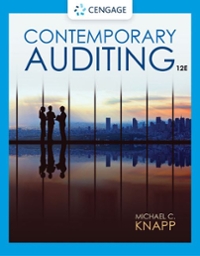Question
You are the Audit Manager of Dawes & Kenneth. You are reviewing the work carried out by the audit teams in relation to the audits
You are the Audit Manager of Dawes & Kenneth. You are reviewing the work carried out by the audit teams in relation to the audits of two unrelated clients, Shipton Hotels and Telford. Both clients are listed companies and their respective accounting years ended on 31 May 2020.
The following matters have been highlighted in relation to each audit client:
i. Shipton Hotels
Shipton Hotels leases various properties and equipment. The company has not applied IFRS 16 Leases for reporting these leases in the financial statements. Had it applied IFRS 16, the companys total assets would have increased by 400 million, and its lease liability would have increased by a similar amount. In addition, the net charge to the statement of profit or loss for the excess depreciation and finance charge would have been 45 million.
On 01 September 2019, Shipton Hotels invested 70 million in acquiring 80% stake in Pembury, a rival hotel which is struggling to survive under current global lockdown conditions. Goodwill of 12 million was recognised at the date of acquisition of Pembury but no impairment review had since been carried out. The directors had justified the decision not to carry out impairment review of goodwill on acquisition of Pembury with the explanation that the current problems being faced by the travel and hotel industry would be over very quickly. Shipton Hotels reported profit before tax of 30 million for the year ended 31 May 2020: total assets of 500 million and total non-current liabilities of 390 million.
ii. Telford
There is a pending lawsuit at the High Court against Telford by one of its customers. The customer is seeking damages for 10 million for breach of contract. Dawes & Kenneths audit team sought the opinion of Telfords solicitors about the likely outcome of the lawsuit and the solicitors sent a written reply to the effect that the lawsuit would probably go against Telford. The directors of Telford are of the view that a disclosure of the likely liability as a contingent liability would be sufficient as the judgement on the case has not yet been delivered, and even if the case goes against Telford at the High Court, they intend to appeal all the way to the Supreme Court.
Telfords profit before tax for the year ended 31 May 2020 was 25 million.
Required:
If each of the above cases remains unresolved at the date of preparing the audit report, explain the impact on the audit opinion to be expressed in the audit report.
b) In reviewing the audit working papers of the engagement team on the audit of Derby Smartwear plc for the year ended 31 May 2020, you came across
the following:
Classification and presentation of adjusted items
Current year items relating principally to impairment, loss on disposal of discontinued operations, property rationalisation, restructuring costs, and refinancing costs have been treated and disclosed as adjusting items, as detailed by Management in note xx. The total impact of these is to adjust the Group statutory consolidated loss for the period before tax of 67.5 million to an adjusted consolidated loss before tax for the period of 20.2 million. The classification of items as adjusting is an area of judgement. They could also present the opportunity for Management bias in presentation, particularly in light of the pressures which the retail industry is currently facing and the fact that certain financial covenants are based on results before adjusted items. Given the high level of Management judgement involved, we deemed this a potential fraud risk for our audit. The Audit and Risk Committee report on page xx also refers to adjusted items as one of the significant judgements considered by the Committee.
How we responded with the scope of our audit
We evaluated the appropriateness of the adjustments made to the statutory loss for the period to derive the adjusted loss. We completed the following audit procedures:
challenged the appropriateness and classification of these items by testing a sample of these and agreed them back to supporting documentation;
assessed the completeness of any credits to adjusting items;
assessed the consistency of classification of foreign currency adjustments to reflect Managements updated policy; and
considered the nature and scope of the charges and confirmed the costs described as adjusting relate to activities identified in the group accounting policy.
Key observations
We consider the rationale for classifying items as adjusting is consistent year on year, other than the change in treatment of foreign currency adjustments and is in accordance with the groups accounting policy. As appropriately disclosed in Note xx, Management has appropriately amended its policy in respect of the classification of foreign currency adjustments to be in line with market practice.
Required:
Show how the above matter should be disclosed in the audit report and explain the purpose of such disclosure.
Step by Step Solution
There are 3 Steps involved in it
Step: 1

Get Instant Access to Expert-Tailored Solutions
See step-by-step solutions with expert insights and AI powered tools for academic success
Step: 2

Step: 3

Ace Your Homework with AI
Get the answers you need in no time with our AI-driven, step-by-step assistance
Get Started


